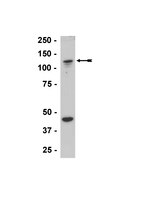ADAP and SKAP55 deficiency suppresses PD-1 expression in CD8+ cytotoxic T lymphocytes for enhanced anti-tumor immunotherapy.
Li, C; Li, W; Xiao, J; Jiao, S; Teng, F; Xue, S; Zhang, C; Sheng, C; Leng, Q; Rudd, CE; Wei, B; Wang, H
EMBO molecular medicine
7
754-69
2015
概要を表示する
PD-1 negatively regulates CD8(+) cytotoxic T lymphocytes (CTL) cytotoxicity and anti-tumor immunity. However, it is not fully understood how PD-1 expression on CD8(+) CTL is regulated during anti-tumor immunotherapy. In this study, we have identified that the ADAP-SKAP55 signaling module reduced CD8(+) CTL cytotoxicity and enhanced PD-1 expression in a Fyn-, Ca(2+)-, and NFATc1-dependent manner. In DC vaccine-based tumor prevention and therapeutic models, knockout of SKAP55 or ADAP showed a heightened protection from tumor formation or metastases in mice and reduced PD-1 expression in CD8(+) effector cells. Interestingly, CTLA-4 levels and the percentages of tumor infiltrating CD4(+)Foxp3(+) Tregs remained unchanged. Furthermore, adoptive transfer of SKAP55-deficient or ADAP-deficient CD8(+) CTLs significantly blocked tumor growth and increased anti-tumor immunity. Pretreatment of wild-type CD8(+) CTLs with the NFATc1 inhibitor CsA could also downregulate PD-1 expression and enhance anti-tumor therapeutic efficacy. Together, we propose that targeting the unrecognized ADAP-SKAP55-NFATc1-PD-1 pathway might increase efficacy of anti-tumor immunotherapy. | | 25851535
 |
Signaling by Fyn-ADAP via the Carma1-Bcl-10-MAP3K7 signalosome exclusively regulates inflammatory cytokine production in NK cells.
Rajasekaran, K; Kumar, P; Schuldt, KM; Peterson, EJ; Vanhaesebroeck, B; Dixit, V; Thakar, MS; Malarkannan, S
Nature immunology
14
1127-36
2013
概要を表示する
Inflammation is a critical component of the immune response. However, acute or chronic inflammation can be highly destructive. Uncontrolled inflammation forms the basis for allergy, asthma and various autoimmune disorders. Here we identified a signaling pathway that was exclusively responsible for the production of inflammatory cytokines but not for cytotoxicity. Recognition of tumor cells expressing the NK cell-activatory ligands H60 or CD137L by mouse natural killer (NK) cells led to efficient cytotoxicity and the production of inflammatory cytokines. Both of those effector functions required the kinases Lck, Fyn and PI(3)K (subunits p85α and p110δ) and the signaling protein PLC-γ2. However, a complex of Fyn and the adaptor ADAP exclusively regulated the production of inflammatory cytokines but not cytotoxicity in NK cells. That unique function of ADAP required a Carma1-Bcl-10-MAP3K7 signaling axis. Our results have identified molecules that can be targeted to regulate inflammation without compromising NK cell cytotoxicity. | Fluorescence Activated Cell Sorting (FACS) | 24036998
 |
Adaptor FYB (Fyn-binding protein) regulates integrin-mediated adhesion and mediator release: differential involvement of the FYB SH3 domain.
Geng, L, et al.
Proc. Natl. Acad. Sci. U.S.A., 98: 11527-32 (2001)
2001
概要を表示する
Aggregation of the high-affinity IgE receptor (FcepsilonRI) on mast cells activates a tyrosine phosphorylation cascade that is required for adhesion and degranulation events leading to the release of histamine and other inflammatory mediators. The full range of intracellular mediators that regulate this process is unknown. Recent studies have identified a group of immune cell-specific adaptor proteins that include linker for activation of T-cell (LAT), SH2-domain-containing leukocyte protein (SLP-76), and Fyn-T-binding protein (FYB)/SLP-76-associated protein (SLAP). In this study, we demonstrate that FYB can up-regulate integrin-mediated adhesion to fibronectin and mediator release in RBL-2H3 mast cells. The regulation of these two events could be distinguished from each other by the requirement of the FYB SH3 domain in beta-hexosaminidase release, but not adhesion, and the up-regulation of mediator release by FYB in nonadherent cells. FcepsilonRI aggregation increased FYB tyrosine phosphorylation, whereas confocal immunofluorescence microscopy showed that FYB colocalizes with F-actin in membrane ruffles and plaques. Our findings identify FYB as a regulator of integrin-mediated adhesion and degranulation events, which, in the case of mast cells, has potential applications to inflammatory and allergic responses. | | 11553777
 |












